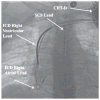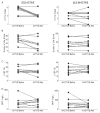Spinal cord stimulation is safe and feasible in patients with advanced heart failure: early clinical experience
- PMID: 24961194
- PMCID: PMC6321984
- DOI: 10.1002/ejhf.107
Spinal cord stimulation is safe and feasible in patients with advanced heart failure: early clinical experience
Abstract
Aims: Pre-clinical work suggests that upper thoracic spinal cord stimulation (SCS) may have therapeutic effects in the treatment of heart failure (HF). We therefore aim to assess the safety and feasibility of SCS in HF patients.
Methods and results: A prospective, randomized, double-blind, crossover pilot study was conducted in symptomatic HF patients receiving optimal medical therapy. Patients were implanted with an SCS system and randomized to an SCS-ACTIVE, delivered at 90% paraesthesia threshold, or an SCS-INACTIVE phase for 3 months, followed by a 1-month washout period and crossover to the alternative phase. The safety of SCS therapy was assessed by death and cardiac events. Implantable cardioverter defibrillator (ICD) function in the presence of SCS was tested by defibrillation testing during SCS system implant and review of real-time and stored electrograms during follow-up. The efficacy of SCS therapy was assessed by changes in patient symptoms, LV function, and BNP level. Nine patients were investigated. In all cases, ICD sensing, detection, and therapy delivery were unaffected by SCS. During follow-up, one patient died and one was hospitalized for HF while in the SCS-INACTIVE phase, and two patients had HF hospitalizations during the SCS-ACTIVE phase. Symptoms were improved in the majority of patients with SCS, while markers of cardiac structure and function were, in aggregate, unchanged.
Conclusion: This study shows that an SCS system can be safely implanted in patients with advanced HF and that the SCS system does not interfere with ICD function.
Keywords: Heart failure; Neuromodulation; Neuroradiology; Neurostimulation.
© 2014 The Authors. European Journal of Heart Failure © 2014 European Society of Cardiology.
Conflict of interest statement
Figures




Similar articles
-
Thoracic Spinal Cord Stimulation for Heart Failure as a Restorative Treatment (SCS HEART study): first-in-man experience.Heart Rhythm. 2015 Mar;12(3):588-595. doi: 10.1016/j.hrthm.2014.12.014. Epub 2014 Dec 12. Heart Rhythm. 2015. PMID: 25500165 Clinical Trial.
-
Determining the Feasibility of Spinal Cord Neuromodulation for the Treatment of Chronic Systolic Heart Failure: The DEFEAT-HF Study.JACC Heart Fail. 2016 Feb;4(2):129-136. doi: 10.1016/j.jchf.2015.10.006. Epub 2015 Dec 9. JACC Heart Fail. 2016. PMID: 26682789 Clinical Trial.
-
Effects of Spinal Cord Stimulation on Cardiac Sympathetic Nerve Activity in Patients with Heart Failure.Pacing Clin Electrophysiol. 2017 May;40(5):504-513. doi: 10.1111/pace.13050. Epub 2017 Mar 23. Pacing Clin Electrophysiol. 2017. PMID: 28206674 Clinical Trial.
-
Combining electrical therapies for advanced heart failure: the Milan experience with biventricular pacing-defibrillation backup combination for primary prevention of sudden cardiac death.Am J Cardiol. 2003 May 8;91(9A):74F-80F. doi: 10.1016/s0002-9149(02)03341-6. Am J Cardiol. 2003. PMID: 12729853 Review.
-
Implantable cardioverter-defibrillators and survival in advanced heart failure patients with continuous-flow left ventricular assist devices: a systematic review and meta-analysis.Europace. 2019 Sep 1;21(9):1353-1359. doi: 10.1093/europace/euz125. Europace. 2019. PMID: 31086951
Cited by
-
Spinal cord stimulation in a patient with an implantable cardioverter defibrillator for managing chronic chest pain: a case report and literature review.Pain Manag. 2024 Oct-Nov;14(10-11):535-540. doi: 10.1080/17581869.2024.2426971. Epub 2024 Nov 14. Pain Manag. 2024. PMID: 39540260 Review.
-
The efficacy of transcutaneous vagus nerve stimulation in heart failure management - a systematic review and meta-analysis.BMC Cardiovasc Disord. 2025 Jul 4;25(1):481. doi: 10.1186/s12872-025-04919-x. BMC Cardiovasc Disord. 2025. PMID: 40615792 Free PMC article.
-
Neuromodulation devices for heart failure.Eur Heart J Suppl. 2022 Aug 17;24(Suppl E):E12-E27. doi: 10.1093/eurheartjsupp/suac036. eCollection 2022 Sep. Eur Heart J Suppl. 2022. PMID: 35991619 Free PMC article.
-
Brain‑heart axis: Neurostimulation techniques in ischemic heart disease (Review).Int J Mol Med. 2025 Oct;56(4):148. doi: 10.3892/ijmm.2025.5589. Epub 2025 Jul 19. Int J Mol Med. 2025. PMID: 40682847 Free PMC article. Review.
-
Neuromodulation in patients with refractory angina pectoris: a review.Eur Heart J Open. 2022 Dec 22;3(1):oeac083. doi: 10.1093/ehjopen/oeac083. eCollection 2023 Jan. Eur Heart J Open. 2022. PMID: 36632476 Free PMC article. Review.
References
-
- Lee AW, Pilitsis JG. Spinal cord stimulation: indications and outcomes. Neurosurg Focus. 2006;21:E3. - PubMed
-
- Raso L, Deer T. Spinal cord stimulation in the treatment of acute and chronic vasculitis: clinical discussion and synopsis of the literature. Neuromodulation. 2011;14:225–228. discussion 228. - PubMed
-
- Claeys LG, Berg W, Jonas S. Spinal cord stimulation in the treatment of chronic critical limb ischemia. Acta Neurochir. 2007;97:259–265. - PubMed
-
- Fanciullo GJ, Robb JF, Rose RJ, Sanders JH., Jr Spinal cord stimulation for intractable angina pectoris. Anesthes Analg. 1999;89:305–306. - PubMed
-
- DeJongste MJ. Spinal cord stimulation for ischemic heart disease. Neurol Res. 2000;22:293–298. - PubMed
Publication types
MeSH terms
Grants and funding
LinkOut - more resources
Full Text Sources
Other Literature Sources
Medical
Research Materials
Miscellaneous

